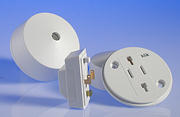- Joined
- 27 Jan 2008
- Messages
- 27,558
- Reaction score
- 3,332
- Location
- Llanfair Caereinion, Nr Welshpool
- Country

I tried LED GU10 some years ago and the results were disappointing so went to cold cathode however over the years this has faded and gone yellow so was replaced with a standard quartz unit.
Then my wife went to Pound World and came back with some GU10 and MR16 0.58W spot lights which on seeing wattage I laughed at. However stuck them in and was surprised how bright. Using as bedside lights they were good enough to read by.
In the bathroom 4 x 50W MR16 were replaced and the results were a rather dim room as one would expect but good enough and since a rather old system using a transformer not an inverter no real problem.
Next was a visit to Lidi and I got two candle type E14 bulbs to use in desk lamp next to key board. Finding one of the 8W globe type bulbs had blown I used one instead in main living room light and was rather surprised at the output. It seemed brighter than the 8W CFU that it replaced but only 1.4W. I aimed camera at the bulbs and 1/30 second F3.5 ISO 140 was shown with both lamps 8W CFU and 1.4W LED and the LED does not have a soft start. I did wait 1/2 hour before measuring.
This was rather a surprise I had considered LED and CFU to be on par so question are my CFU all faulty or are LED lamps better?
I compared at my desk the folded 11W florescent and the 1.4W LED and as expected the 11W is giving far more light out. If I had just one bulb in living room I would have blamed the bulb but 10 in living room and 8 in dinning room the dinning room is a different make and slightly brighter bulbs but this does to me raise the question in general are LED lamps better than CFU?
I also did the CD test tilting it to see the colour spectrum and the CFU gives three well defined colours where the LED there is a gradual blend between each colour likely better for my photography.
I did after look on internet and I do see claims that LED lamps are near half the wattage to CFU to give same light output.
Then my wife went to Pound World and came back with some GU10 and MR16 0.58W spot lights which on seeing wattage I laughed at. However stuck them in and was surprised how bright. Using as bedside lights they were good enough to read by.
In the bathroom 4 x 50W MR16 were replaced and the results were a rather dim room as one would expect but good enough and since a rather old system using a transformer not an inverter no real problem.
Next was a visit to Lidi and I got two candle type E14 bulbs to use in desk lamp next to key board. Finding one of the 8W globe type bulbs had blown I used one instead in main living room light and was rather surprised at the output. It seemed brighter than the 8W CFU that it replaced but only 1.4W. I aimed camera at the bulbs and 1/30 second F3.5 ISO 140 was shown with both lamps 8W CFU and 1.4W LED and the LED does not have a soft start. I did wait 1/2 hour before measuring.
This was rather a surprise I had considered LED and CFU to be on par so question are my CFU all faulty or are LED lamps better?
I compared at my desk the folded 11W florescent and the 1.4W LED and as expected the 11W is giving far more light out. If I had just one bulb in living room I would have blamed the bulb but 10 in living room and 8 in dinning room the dinning room is a different make and slightly brighter bulbs but this does to me raise the question in general are LED lamps better than CFU?
I also did the CD test tilting it to see the colour spectrum and the CFU gives three well defined colours where the LED there is a gradual blend between each colour likely better for my photography.
I did after look on internet and I do see claims that LED lamps are near half the wattage to CFU to give same light output.

